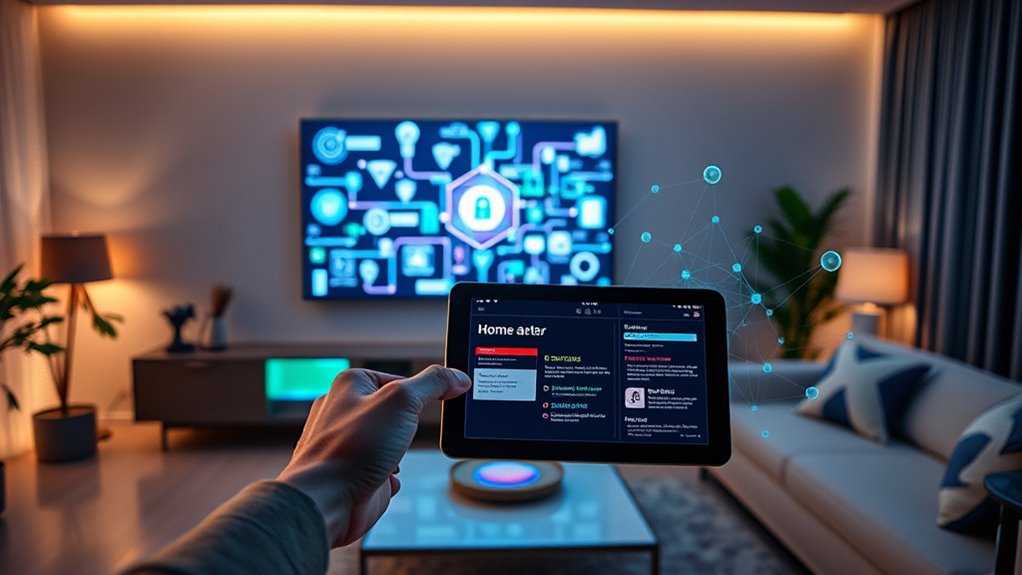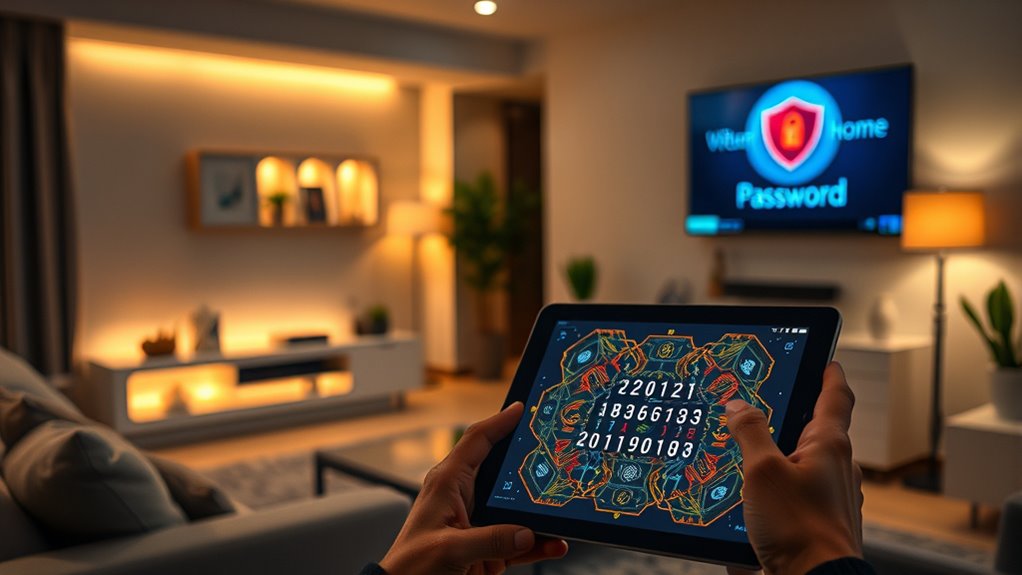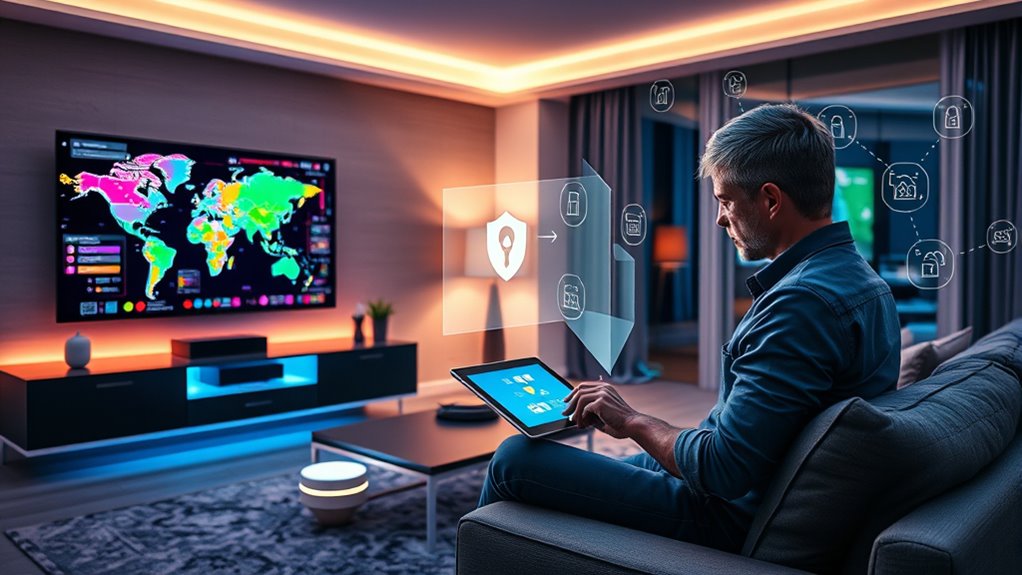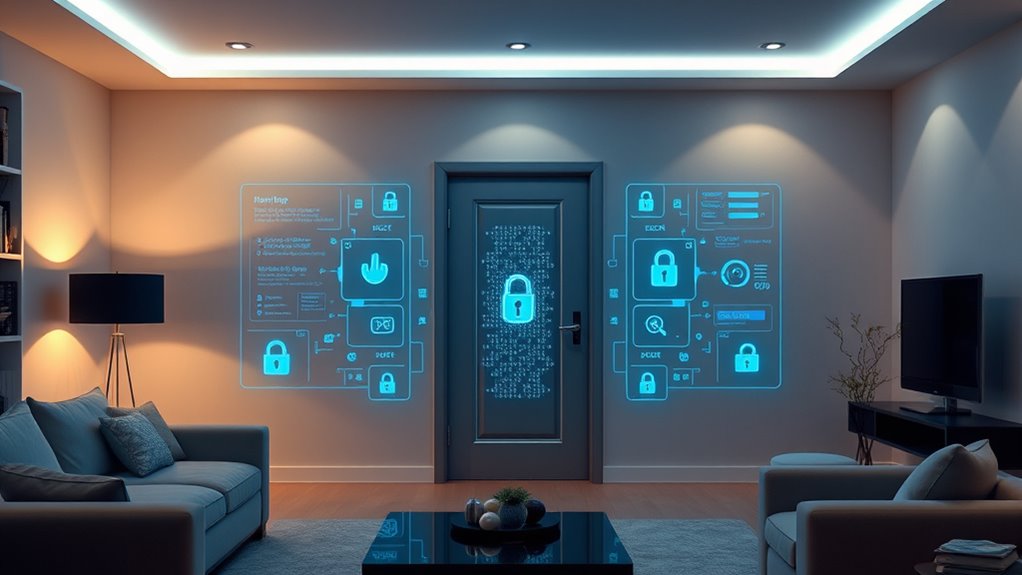In 2025, protecting your smart home means understanding IoT device risks, securing your Wi-Fi with strong encryption like WPA3, and using unique, complex passwords for each device and account. Keep all firmware and software updated regularly, and consider creating separate networks for your devices to reduce vulnerabilities. Stay alert for common threats like phishing and malware, and educate your household about cybersecurity best practices. Continue exploring these tips to keep your home truly secure.
Key Takeaways
- Regularly update device firmware and software to patch security vulnerabilities in smart home devices.
- Use strong, unique passwords and enable multi-factor authentication for all smart home accounts.
- Segment your network with separate Wi-Fi for IoT devices to limit potential breaches.
- Educate household members on recognizing phishing, scams, and social engineering tactics.
- Enable robust Wi-Fi encryption like WPA3 and disable remote management features for enhanced security.
Understanding the Risks of IoT Devices in Your Home

While IoT devices offer convenience and automation in your home, they also introduce significant security risks. Many devices have vulnerabilities that hackers can exploit, putting your network and personal data at risk. Device vulnerabilities often stem from weak passwords, outdated software, or poor security design, making it easier for cybercriminals to gain access. These breaches not only compromise your privacy but can also give attackers control over your smart home features. Privacy concerns are a major issue, as many IoT devices collect sensitive information about your daily routines, habits, and personal details. Without proper safeguards, this data can be exposed or misused. Understanding these risks helps you stay alert and take proactive steps to protect your smart home environment. Additionally, using vintage decor and other aesthetic elements can sometimes introduce less secure, older technology that may lack modern security features.
Securing Your Wi-Fi Network Effectively

Securing your Wi-Fi network is the first line of defense against cyber threats targeting your smart home. Start by enabling strong Wi-Fi encryption, such as WPA3, to protect your data from eavesdroppers. Avoid using default passwords for your router, and update its firmware regularly to patch vulnerabilities. Proper router placement is equally important; position it centrally in your home to ensure even coverage and reduce dead spots, which can be exploited by hackers. Keep your router away from windows and exterior walls to minimize signal leakage. Disabling remote management features adds another layer of security. By combining robust Wi-Fi encryption with strategic router placement, you make it considerably harder for intruders to access your network and devices. Regularly reviewing your security settings helps maintain a secure smart home environment.
Choosing and Managing Strong Passwords

Have you ever considered how vulnerable your smart home could be if your passwords are weak or reused? To protect your devices, focus on password complexity—use a mix of uppercase, lowercase, numbers, and symbols. Managing your passwords is essential; avoid reusing the same password across accounts. Instead, create unique ones for each device. Consider using a password manager to keep track of your credentials securely. Here’s an example of a strong password setup:
| Device | Recommended Password Traits | Example |
|---|---|---|
| Smart Thermostat | Mix of uppercase, lowercase, numbers, symbols | T!m3C@t2025 |
| Security Cameras | At least 12 characters, no common words | V!p9x#7kQ4mL |
| Door Lock | Unique, unpredictable, complex | R#8k2@Lp9!Xq |
Strong passwords and management keep your smart home safer. Additionally, consider using a reputable password manager to streamline your security practices.
Keeping Firmware and Software Up to Date

Keeping your smart home devices up to date is essential because outdated firmware and software often contain security vulnerabilities that hackers can exploit. Regularly applying firmware updates and software patches guarantees your devices stay protected against emerging threats. To stay current, consider these steps:
- Enable automatic updates whenever possible to receive firmware updates and patches instantly.
- Regularly check device manufacturer websites or apps for the latest software patches and firmware releases.
- Remove or disable unused apps and services that may pose security risks due to outdated software.
Implementing Network Segmentation for Enhanced Security

To boost your smart home security, consider isolating your IoT devices from your main network. Creating virtual networks helps prevent potential breaches from spreading, while monitoring network traffic keeps you aware of unusual activity. These steps make it harder for hackers to access your sensitive information or control your devices. Additionally, implementing robust safety measures can further protect your smart home from emerging AI vulnerabilities.
Isolate IoT Devices
Implementing network segmentation is one of the most effective ways to protect your smart home from cyber threats. By isolating IoT devices, you prevent potential breaches from spreading across your network. This process, known as device isolation, ensures that compromised devices can’t access sensitive data or other connected systems. To optimize security, consider these steps:
- Create separate network segments for IoT devices and personal computers.
- Use strong, unique passwords for each device and segment.
- Regularly update firmware to patch vulnerabilities within each network segment.
- Be aware of privacy policies and how data is collected and shared across your devices to maintain control over your personal information.
Create Virtual Networks
Creating virtual networks is a practical way to enhance your smart home’s security by segmenting different device types. With a proper virtual network setup, you isolate sensitive devices from less secure ones, reducing the risk of cyberattacks. Network virtualization allows you to create separate virtual environments within your existing network, making it harder for hackers to move laterally if they breach one segment. By implementing network segmentation, you limit access and contain potential threats, protecting your personal data and IoT devices. This approach also simplifies managing device permissions and updates. Overall, creating virtual networks strengthens your smart home’s defenses, giving you greater control over each device’s security and minimizing vulnerabilities across your network infrastructure. Incorporating network segmentation is especially effective when combined with practices like regular firmware updates and strong password management to further bolster your smart home security.
Monitor Network Traffic
Monitoring network traffic is essential for maintaining the security of your segmented smart home network. By regularly analyzing traffic, you can identify unusual patterns that may indicate a security breach. Effective traffic analysis helps you detect anomalies early, preventing potential attacks. To enhance your monitoring efforts, focus on these key actions:
- Use traffic analysis tools to visualize data flow and identify irregular activity.
- Set up anomaly detection systems that alert you to suspicious behavior in real-time.
- Segment your network further to isolate devices and limit the impact of any detected threats.
- Incorporate emotional support strategies to respond calmly and effectively to security incidents.
This proactive approach ensures that you stay ahead of cyber threats, maintaining a secure environment for all your smart devices. Regular monitoring empowers you to respond swiftly, minimizing damage and safeguarding your smart home.
Recognizing and Avoiding Common Cyber Threats

Understanding common cyber threats is essential to keeping your smart home safe. Phishing scams and social engineering attacks often target you through emails, messages, or calls, tricking you into revealing sensitive information. Recognizing these threats helps you avoid falling victim. Be cautious of unsolicited requests for passwords or personal details, and verify the sender’s identity before responding. Use the table below to identify common threats and their indicators:
| Threat | How to Recognize | Prevention Tips |
|---|---|---|
| Phishing scams | Suspicious links or urgent language | Don’t click unknown links; verify sender |
| Social engineering | Unusual requests or pressure tactics | Confirm identities before sharing info |
| Malware | Unexpected downloads or pop-ups | Keep software updated and run scans |
Stay alert, and don’t let cybercriminals exploit your trust.
Best Practices for Smart Home Privacy and Data Protection

To protect your smart home’s privacy, you must adopt proactive data protection practices. First, enable and regularly review user privacy settings on all devices to control what data is shared and with whom. Second, implement data encryption for your network traffic and stored data, ensuring that sensitive information remains secure even if a breach occurs. Third, keep your device firmware and software up to date, closing security loopholes that could be exploited. These steps help safeguard your personal information from cyber threats. Additionally, understanding the types of smart home devices you use can help you better assess potential vulnerabilities and tailor your security measures accordingly. By actively managing user privacy settings, applying data encryption, and maintaining your devices, you create multiple layers of defense, making it harder for unauthorized users to access your smart home data.
Frequently Asked Questions
How Can I Identify if My Smart Device Has a Security Vulnerability?
To identify if your smart device has a security vulnerability, start by checking its device firmware for updates. Manufacturers often release patches for known issues. Also, verify your device uses network encryption, like WPA3, which protects your data during transmission. If your device lacks the latest firmware updates or doesn’t support strong encryption, it could be vulnerable. Regularly review your device settings and update them to stay secure.
What Legal Rights Do I Have if My Smart Home Is Hacked?
If your smart home gets hacked, your privacy rights come into play, and you may have legal recourse against the manufacturer or service provider if negligence is involved. You should document the breach and report it to relevant authorities. Laws vary by location, so consulting a legal professional helps you understand your rights and options for seeking compensation or protection. Stay informed about your privacy rights to better defend yourself.
Are Biometric Security Features More Secure Than Traditional Passwords?
Biometric security features are generally more secure than traditional passwords because of their biometric accuracy, making it harder for hackers to replicate. Unlike password complexity, which can be guessed or stolen, biometrics rely on unique physical traits like fingerprints or facial scans. However, no system is foolproof. You should combine biometric security with other measures to maximize protection and keep your smart home safe from intruders.
How Do I Securely Share Smart Home Access With Family or Guests?
Did you know that 60% of smart home breaches involve insecure guest access? To keep your home secure, use guest access features with time-limited or one-time codes, avoiding shared passwords. Always update your device firmware, and revoke guest access when it’s no longer needed. This guarantees secure sharing, minimizes risks, and keeps your smart home safe from unauthorized entry or breaches.
What Are the Latest Trends in Smart Home Cybersecurity Technology?
You should know that the latest trends in smart home cybersecurity include cloud-based security systems that offer real-time monitoring and enhanced protection. AI threat detection is also growing, enabling your devices to identify and respond to potential security breaches automatically. These advancements help you stay ahead of cyber threats, ensuring your smart home remains safe and secure. Staying updated on these trends allows you to better protect your connected devices and personal data.
Conclusion
Think of your smart home as a castle. The IoT devices are your guards, but without strong walls—like secure networks and updates—they’re vulnerable. By staying vigilant and practicing good cybersecurity habits, you’re building a fortress that’s tough to breach. Remember, a well-protected home isn’t just about devices; it’s about safeguarding your sanctuary. Keep your defenses strong, and your digital castle will stand tall against any threat that comes your way.








